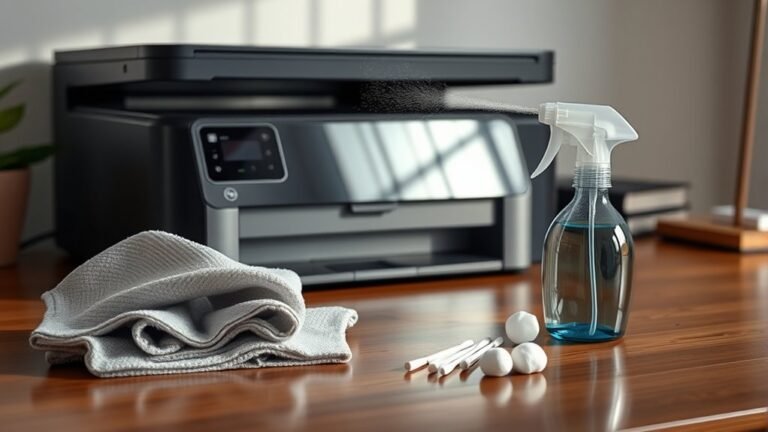The Best Way to Clean Your Computer Monitor
The best way to clean your computer monitor is to first turn it off and unplug it. Use a soft microfiber cloth to gently wipe away dust without scratching. Lightly dampen the cloth with distilled water or a gentle vinegar solution—never spray liquid directly on the screen. Avoid harsh chemicals like ammonia, which can damage coatings. Regular, careful cleaning keeps your screen clear and vibrant. Keep going to find out how to protect your monitor and troubleshoot common issues.
Understanding Different Types of Computer Screens

Before you start cleaning, it’s important to know what type of screen you’re dealing with. Whether it’s LCD screens or vibrant OLED displays, each uses different LED technology that affects how you should clean them. Touchscreen monitors, for example, often have special anti glare coatings to protect their surface and enhance visibility. Understanding your panel types—like IPS or TN—helps you appreciate variations in display brightness, refresh rates, and color accuracy. The screen resolutions also matter, as higher resolutions demand more care to avoid scratches or damage. Knowing these details gives you the freedom to maintain your monitor’s quality without risking harm. By respecting your monitor’s specific traits, you guarantee it stays sharp, clear, and ready for your next adventure.
Essential Cleaning Supplies for Your Monitor
To keep your monitor spotless, you’ll want to use the right cleaning materials like microfiber cloths and gentle, screen-safe solutions. Avoid harsh chemicals like ammonia or alcohol, as they can damage the screen’s coating. Choosing the proper supplies guarantees a clean screen without risking any harm.
Recommended Cleaning Materials
You’ll need a few key items to safely clean your computer monitor without causing damage. Choosing the right materials gives you the freedom to maintain a crystal-clear screen without worry. Here are the essentials you should have on hand:
- Microfiber cloths – gentle and lint-free, perfect for wiping without scratching.
- Distilled water – free of minerals that can leave spots or damage coatings.
- Spray bottle – to lightly mist your cleaning solution for even application.
- A small amount of isopropyl alcohol (optional) – for stubborn smudges, but use sparingly.
Stick to these recommended materials to keep your monitor spotless and protect its delicate surface. This simple setup guarantees you clean effectively while preserving your screen’s clarity and longevity.
Avoiding Harmful Chemicals
Although it might be tempting to reach for common household cleaners, you should avoid harsh chemicals when cleaning your monitor. These substances can damage the screen’s delicate coating and reduce its lifespan. Instead, opt for eco friendly alternatives that protect both your device and the environment. Screen safe solutions like distilled water or a gentle mix of vinegar and water are your best bet. Here’s a quick guide to what you should and shouldn’t use:
| Use | Avoid | Why |
|---|---|---|
| Distilled Water | Ammonia-Based Cleaners | Prevents coating damage |
| Vinegar & Water Solution | Bleach | Eco friendly and safe |
| Microfiber Cloth | Paper Towels | Avoids scratches |
| Screen Safe Sprays | Alcohol | Maintains screen integrity |
Choosing wisely means freedom from worry and a longer-lasting monitor.
Step-by-Step Guide to Cleaning Your Screen Safely

When cleaning your computer monitor, it’s important to use the right materials and techniques to avoid damage. Proper cleaning techniques guarantee your screen stays clear and your device lasts longer. Here’s a simple, safe step-by-step guide for screen maintenance:
Using the right materials and techniques ensures a clear screen and longer-lasting device.
- Turn off your monitor and unplug it to prevent electrical issues.
- Use a microfiber cloth to gently wipe away dust—no paper towels or rough fabrics.
- Lightly dampen the cloth with distilled water or a 50/50 mix of distilled water and white vinegar; never spray liquid directly on the screen.
- Wipe the screen in gentle, circular motions to avoid streaks and pressure marks.
Follow these steps regularly, and you’ll enjoy a spotless display without risking damage or voiding your freedom to clean as you please.
Tips to Avoid Damage While Cleaning
To keep your monitor safe during cleaning, it’s essential to avoid harsh chemicals and abrasive materials that can scratch or discolor the screen. Instead, use a soft microfiber cloth to gently wipe away dust and fingerprints, preventing scratches. Spray your cleaning solution onto the cloth, not directly on the screen, to avoid moisture seeping into the device. When cleaning, apply light pressure and use circular motions to minimize streaks. Steer clear of paper towels, tissues, or rough fabrics—they can leave fibers behind or damage the surface. Also, refrain from using ammonia-based or alcohol cleaners, as they may strip protective coatings. By following these tips, you’ll keep your monitor clear and vibrant while avoiding streaks and preventing scratches, preserving your screen’s freedom to display crisp visuals.
How Often Should You Clean Your Monitor?

You should clean your monitor regularly to keep the screen clear and reduce eye strain. How often depends on your environment, but a quick wipe once a week usually works well. If you notice dust, smudges, or reduced screen clarity, it’s time to clean it right away.
Cleaning Frequency Guidelines
Regularly cleaning your computer monitor helps maintain clear visuals and prevents buildup of dust and smudges that can affect your viewing experience. Establishing a cleaning schedule tailored to your needs guarantees your screen stays pristine without unnecessary effort. Here are key frequency factors to take into account:
- Usage Time: The more hours you spend, the more often you should clean.
- Environment: Dusty or smoky surroundings call for more frequent cleaning.
- Touch Frequency: If you often touch the screen, wipe it down regularly.
- Personal Preference: Some prefer a spotless screen daily; others find weekly sufficient.
Signs Monitor Needs Cleaning
How can you tell when your monitor really needs a cleaning? Keep an eye out for clear monitor cleanliness indicators like noticeable dust, fingerprints, or streaks that reduce screen clarity. If you catch yourself squinting or adjusting your angle to avoid glare or smudges, that’s a strong sign your screen demands attention. Screen smudge detection isn’t just about spotting obvious marks; subtle haziness or dullness in image quality also signals it’s time to clean. Since your monitor is a window to digital freedom, maintaining its pristine condition helps you focus without distractions. Don’t wait for dirt to build up—regularly inspect your screen under natural light for these signs, and you’ll enjoy a crisp, clear display that empowers your work and creativity.
Troubleshooting Common Cleaning Issues
Although cleaning your computer monitor usually goes smoothly, you might occasionally run into issues like streaks, smudges, or even damage to the screen. To keep your display clear and safe, here’s how to troubleshoot common cleaning problems:
- For streak removal, always use a microfiber cloth dampened with a mix of distilled water and isopropyl alcohol—avoid paper towels.
- To prevent dust buildup, clean your workspace regularly and consider a screen protector.
- If smudges persist, check if your cleaning solution is too harsh; switch to a gentler mix.
- Avoid spraying liquids directly on the screen; instead, apply to the cloth to prevent moisture damage.
Frequently Asked Questions
Can I Use Screen Cleaning Wipes on My Laptop Monitor?
You can use screen cleaning wipes on your laptop monitor, but you’ve gotta make sure they’re designed specifically for screens to keep laptop safety in check. Regular wipes might have harsh chemicals that could damage the display or leave streaks. By choosing the right screen cleaning products, you maintain a clear view without risking harm. So, go ahead and clean freely, just be mindful about what wipes you pick for your laptop screen.
Is It Safe to Clean a Touchscreen With Alcohol-Based Cleaners?
Sure, if you want your touchscreen to develop a personality of its own—maybe crack or lose its shine—go ahead and douse it with alcohol-based cleaners. But if you value freedom from expensive repairs, you’ll remember that touchscreen materials like Gorilla Glass don’t love harsh chemicals. Instead, opt for alternative cleaners like diluted vinegar or specialized screen sprays. You deserve a clean screen without sacrificing its smooth, flawless touch. Choose wisely!
How Do I Remove Permanent Marker From a Monitor Screen?
If you want to remove permanent marker from your screen, try gentle marker removal techniques first. Use a soft cloth slightly dampened with a monitor cleaning solution designed for screens—avoid harsh chemicals that could damage the display. You might also try a bit of isopropyl alcohol on a microfiber cloth, but test a small area first. Take your time; with patience, you’ll free your screen from marker marks without risking harm.
Can Cleaning My Monitor Improve Its Display Quality?
Absolutely, cleaning your monitor can boost display clarity and enhance your overall visual experience. Dust, fingerprints, and smudges can dull the screen, making images look fuzzy or washed out. By regularly wiping it down with the right materials, you’ll free your monitor from grime that blocks crisp visuals. This simple step lets you enjoy sharper colors and clearer details, giving you the freedom to fully immerse yourself in whatever you’re viewing.
Should I Turn off the Monitor Before Cleaning It?
You should definitely turn off your monitor before cleaning it. Doing this not only helps you see smudges and dust better but also guarantees monitor safety by preventing electrical issues during cleaning. Using proper cleaning techniques, like a soft microfiber cloth and gentle movements, keeps your screen safe and scratch-free. Taking these steps gives you the freedom to keep your display looking sharp without risking damage or voiding warranties.






